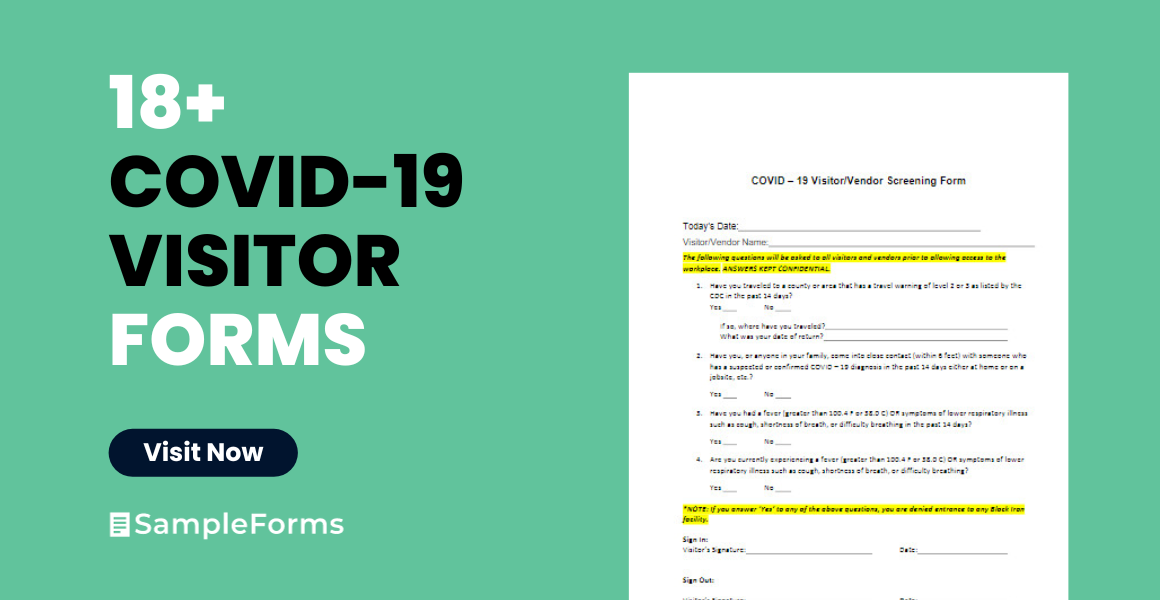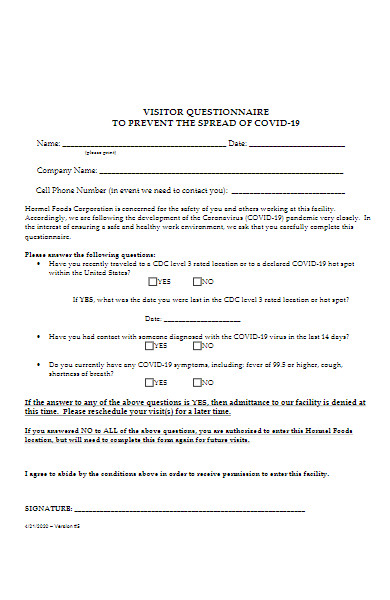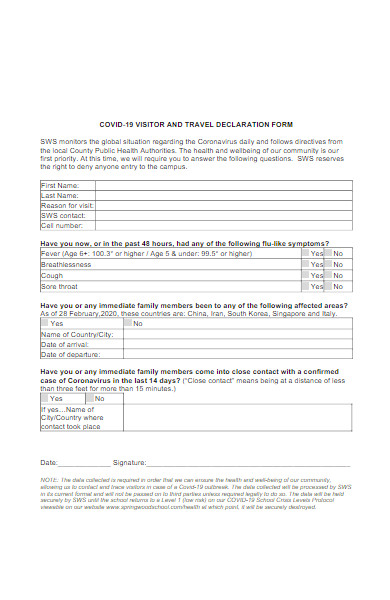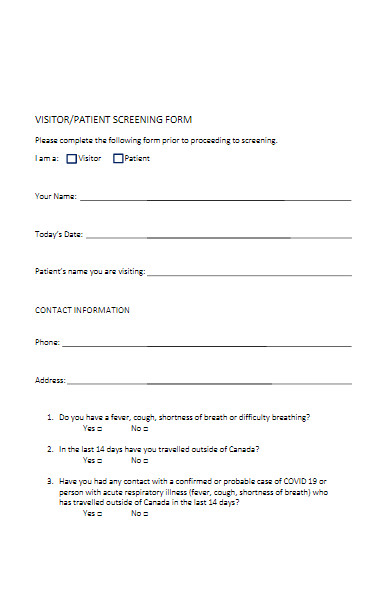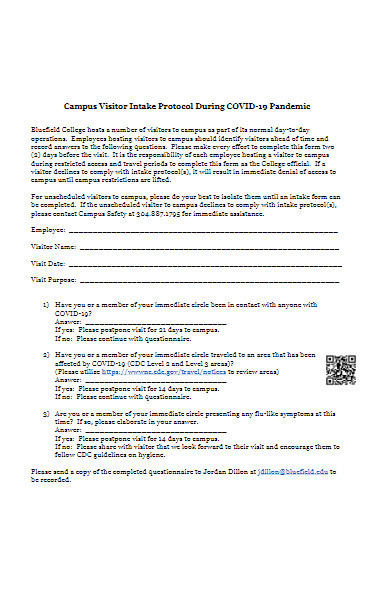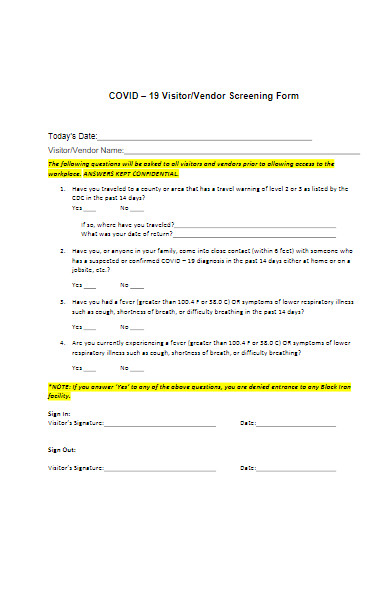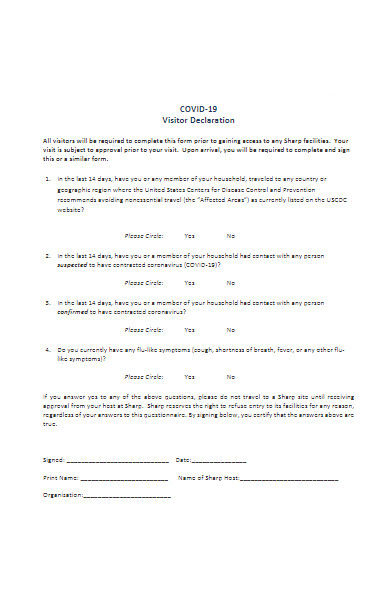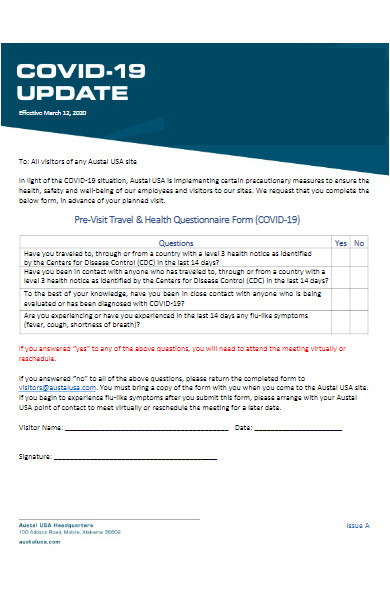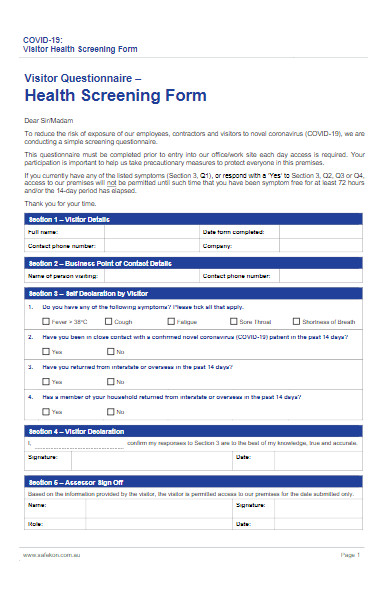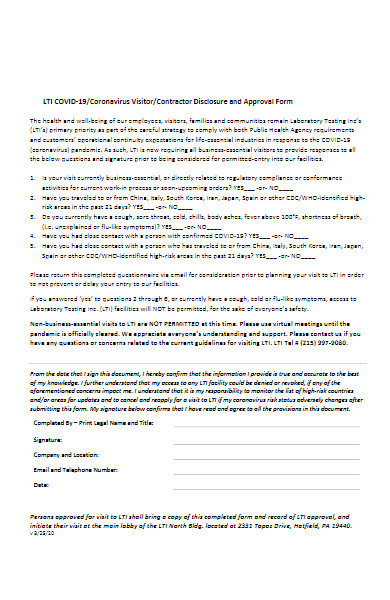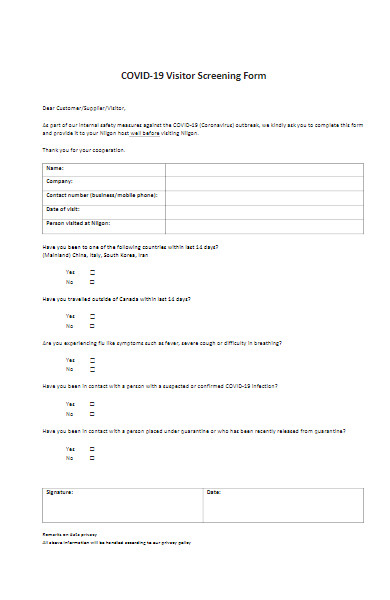In the wake of the global pandemic, businesses, institutions, and public spaces have adopted preventive measures to trace and manage potential outbreaks. Integral to these efforts is the COVID-19 Visitor Form—a tool designed to screen and record details of visitors for health and safety purposes. It captures vital information, ensuring everyone’s well-being while providing a reference point should contact tracing become necessary. This guide delves into its significance, the various printable forms it can take, illustrative examples, creation steps, and best practices to optimize its use.
What is a COVID-19 Visitor Form ? – Definition
A COVID-19 Visitor Form is a document or electronic questionnaire used by establishments to screen and record the details of visitors during the COVID-19 pandemic. Its primary purpose is to identify individuals who might pose a potential health risk by documenting their recent travel history, health status, and contact information. This aids in early detection and efficient contact tracing in case of a potential outbreak, ensuring the safety and health of both the visitors and the establishment’s occupants.
What is the Meaning of a COVID-19 Visitor Form?
The meaning of a COVID-19 Visitor Form extends beyond mere data collection. It symbolizes the rigorous and preventive measures taken by institutions to combat the spread of the virus. This form serves as a gatekeeper, evaluating the potential risk a visitor may bring into an establishment. By asking about recent travels, symptoms, or exposure to confirmed cases, it helps in making informed decisions about granting access. Moreover, in the event of a positive case detection, the recorded details become pivotal for timely and effective contact tracing, thereby minimizing further spread and ensuring public health safety.
What is the Best Sample COVID-19 Visitor Form?
While the specific details and design might vary depending on regional guidelines, organizational needs, and the nature of the establishment, here’s a sample COVID-19 Visitor Form for reference:
Date: [__________]
Visitor’s Name: [__________]
Phone Number: [__________]
Email: [__________]
Purpose of Visit: [__________]
1. Have you traveled internationally in the last 14 days?
- Yes
- No
2. Have you been in close contact with someone who has traveled abroad within the last 14 days?
- Yes
- No
3. Have you had close contact with or cared for someone diagnosed with COVID-19 within the last 14 days?
- Yes
- No
4. Have you experienced any of the following symptoms in the last 14 days? (Check any that apply)
- Fever or chills
- Cough
- Shortness of breath or difficulty breathing
- Fatigue
- Muscle or body aches
- New loss of taste or smell
- Sore throat
- Congestion or runny nose
- Nausea or vomiting
- Diarrhea
5. Have you been tested for COVID-19?
- Yes, tested positive
- Yes, tested negative
- No
If tested positive, specify the date: [__________]
Declaration: I hereby confirm that the information provided herein is accurate, correct, and complete.
Signature: [__________]
It’s worth noting that this is a basic template. Depending on the nature of the organization and its location, more detailed or specific questions might be necessary. Additionally, it’s always advisable to keep abreast of updates from health departments to ensure that your fillable form remains relevant and effective.
FREE 10+ COVID-19 Visitor Forms
What is the purpose of the COVID-19 Visitor Form?
The purpose of the COVID-19 Visitor Form is multifaceted, aiming to protect both individuals and the broader community. Here’s a breakdown of its primary objectives:
- Health Screening: One of the most immediate purposes of the form is to screen visitors for symptoms of COVID-19 or recent exposures to confirmed cases. By identifying potential carriers before they enter a facility, it helps reduce the risk of transmission.
- Contact Tracing: If an individual who visited a facility is later confirmed to have COVID-19, the form provides a record of their visit. This can be vital for contact tracing efforts, allowing for timely notification of others who might have been exposed.
- Capacity Management and Social Distancing: By tracking the number of visitors at any given time, organizations can manage capacity and ensure that social distancing guidelines are maintained.
- Data Collection and Analysis: Over time, the aggregated data from these forms can provide insights into patterns of potential exposures or hotspots, aiding public health strategies.
- Awareness and Education: The act of filling out the form serves as a reminder to visitors about the symptoms and risks associated with COVID-19, promoting greater public awareness.
- Legal and Compliance Purposes: Having a record of visitors and their health status can be crucial for legal reasons, especially if there’s a need to prove that an organization took reasonable steps to prevent transmission.
- Building Trust: Implementing and strictly adhering to such protocols can increase trust among visitors, clients, or employees, assuring them that necessary precautions are being taken for their safety.
Overall, the COVID-19 Visitor Form is a tool that aids in the proactive management of public health during the pandemic, ensuring safer environments for everyone.
How often should a visitor fill out the COVID-19 Visitor Form?
A visitor should fill out the COVID-19 Visitor Form every time they enter a facility or an establishment that requires it. Here’s why:
- Daily Health Status Can Change: A person’s health status and potential exposure to COVID-19 can change daily. A visitor might be symptom-free one day and develop symptoms the next, or they might come into contact with a confirmed case after their last visit.
- Contact Tracing: If a COVID-19 case is identified within a facility, having a daily record of all visitors will be crucial for accurate contact tracing. Without daily records, it would be challenging to identify and notify individuals who might have been exposed.
- Dynamic Situations and Exposures: Given the incubation period of the virus and the possibility of asymptomatic carriers, someone might only become aware of a risky exposure several days after the fact. Daily forms ensure that such evolving situations are captured.
- Consistency and Compliance: Requesting the form to be filled out during every visit ensures a consistent approach and makes compliance easier to monitor and enforce.
- Legal Protection: For businesses and organizations, having a consistent record of daily health checks can serve as evidence that they were taking the necessary precautions to protect visitors and staff.
- Psychological Assurance: Regularly filling out the form can serve as a reminder for visitors to be conscious of their health and potential exposures. It can also provide reassurance to other visitors and staff that everyone’s health is being monitored.
Given these reasons, while it might seem repetitive, having visitors complete the COVID-19 Visitor Form during each visit is a prudent practice during the pandemic. However, the frequency might vary based on local health guidelines, the nature of the facility, and the current status of the pandemic in a particular region. Always adhere to local health department recommendations and guidelines. You also browse our Patient Information Form.
Is the COVID-19 Visitor Form mandatory for all visitors?
The requirement for a COVID-19 Visitor Form varies by jurisdiction, facility type, and specific circumstances. Here are some general considerations:
- Local and Regional Regulations: Many local or regional governments have instituted health and safety protocols that businesses and public spaces must adhere to. Depending on the jurisdiction, these protocols might mandate that all visitors to certain types of facilities or events complete a health declaration or screening form.
- Type of Facility: High-risk facilities, such as hospitals, nursing homes, and long-term care facilities, are more likely to mandate COVID-19 Visitor Forms due to the vulnerable nature of their inhabitants. Similarly, large gatherings or events may have stricter protocols in place.
- Business or Organization Policy: Even if not mandated by local regulations, some businesses or organizations might implement a COVID-19 Visitor Form as part of their own risk management strategy and to reassure staff and other visitors.
- Situation-Dependent: The requirement for a form can also depend on the current COVID-19 situation in the region. For instance, if there’s an outbreak or surge in cases, stricter measures, including mandatory forms, might be temporarily put in place.
- Digital vs. Physical Forms: Some establishments might use digital forms or apps to make the process more seamless and avoid physical paperwork. In such cases, visitors might be required to complete the form via their smartphone before entering.
- Enforcement: While a facility might mandate the form, enforcement can vary. Some places may have strict checks, refusing entry to those who haven’t completed the form, while others might operate on an honor system.
- Legal and Privacy Concerns: Mandating a COVID-19 Visitor Form brings up considerations about personal data protection and privacy. It’s essential that these forms are compliant with local data protection regulations, and visitors should be informed about how their data will be used and stored.
In conclusion, while many places may require a COVID-19 Visitor Form, it’s not universally mandatory everywhere. Visitors should check with the specific facility they’re planning to visit and stay updated on local health guidelines and regulations.
How is the data from the COVID-19 Visitor Form stored and protected?
Storing and protecting data from a COVID-19 Visitor Form is crucial not only for the safety and security of the individuals providing the information but also to ensure compliance with data protection regulations. Here’s how the data is typically stored and protected:
- Data Collection Method:
- Physical Forms: If the data is collected on paper forms, these should be stored in a secure location, such as a locked filing cabinet, and access should be limited to authorized personnel only.
- Digital Forms: Digital data collection is often done via secure web forms or apps. These systems should use encrypted transmissions (e.g., SSL/TLS) to ensure the data is protected while in transit.
- Data Storage:
- Digital Storage: Digital data should be stored on secure servers, preferably with encryption both at rest and in transit. Regular backups of the data should be taken and stored securely.
- Physical Storage: As mentioned, physical forms should be stored securely. If the data from these forms is transferred to digital databases, the original paper forms should either be securely stored or properly destroyed.
- Access Control:
- Limit access to the data to only those who need it for legitimate purposes.
- Implement strong authentication methods, such as two-factor authentication, for digital systems.
- Maintain an access log to keep track of who accessed the data and when.
- Data Retention:
- Data from the COVID-19 Visitor Form should not be kept indefinitely. Determine a clear retention period based on regulatory and operational requirements, after which the data should be securely deleted or destroyed.
- Some jurisdictions may have specific guidelines on how long such data can be retained.
- Privacy Compliance: Ensure that the data collection, storage, and processing practices comply with local data protection and privacy laws, such as the General Data Protection Regulation (GDPR) in Europe or the Health Insurance Portability and Accountability Act (HIPAA) in the U.S., if applicable.
- Transparency: Inform visitors about how their data will be used, stored, and protected. This can be done via a privacy notice or policy provided at the time of data collection.
- Data Protection Measures:
- Employ firewalls, anti-malware tools, and other cybersecurity measures to protect against unauthorized access or breaches.
- Regularly update and patch software to fix known vulnerabilities.
- Train staff on data protection principles and best practices.
- Incident Response Plan: Have a plan in place to respond to any security incidents or data breaches. This should include steps to notify affected individuals and relevant regulatory bodies, if required.
- Third-party Vendors: If third-party vendors are involved in any aspect of the data handling process, ensure they have stringent data protection measures in place and are contractually obligated to uphold those standards.
In summary, data from the COVID-19 Visitor Form is sensitive and should be treated with the utmost care. Proper storage, protection, and compliance measures are essential to safeguard individual privacy and maintain trust.
Who has access to the information I provide on the COVID-19 Visitor Form?
Access to the information provided on a COVID-19 Visitor Form typically depends on the organization or entity collecting the data, the purpose of the form, and any relevant regulations or guidelines in place. Generally, the following groups or individuals might have access to this information:
- Authorized Personnel within the Organization: This typically includes individuals responsible for health and safety measures, facility management, or HR personnel. They use the data to monitor and manage potential health risks.
- Medical and Health Professionals: In cases where a potential health risk is identified, such as if a visitor reports symptoms or recent exposure to COVID-19, health professionals might be alerted to conduct further assessments or contact tracing.
- Government or Public Health Authorities: Depending on local regulations and the nature of the information, public health authorities may require organizations to share data for contact tracing or to monitor the spread of the virus. This could be the case during an outbreak or when a positive case is identified.
- Third-party Service Providers: Some organizations may use third-party software or services to collect, store, or process data from visitor forms. These providers should be contractually bound to protect the data and use it only for the agreed-upon purposes.
- Legal or Regulatory Bodies: In certain situations, such as a legal dispute or compliance check, legal or regulatory bodies may request access to the data.
- Security Personnel: In larger organizations or venues, security personnel might have access to a visitor’s entry or exit data for safety and logistical reasons.
For transparency and to ensure trust:
- Organizations should clearly communicate who will have access to the data provided on the COVID-19 Visitor Form.
- They should also specify the purposes for which the data will be used.
- If there’s a privacy policy or data protection notice provided at the time of data collection, it should detail data access, storage, and usage protocols.
It’s important to remember that access to this information should be limited to those who genuinely need it for legitimate purposes, and there should be stringent data protection measures in place to prevent unauthorized access. If you are concerned about who might have access to your data, always ask the collecting organization for clarification. You should also take a look at our History Form.
Can I see or get a copy of my filled-out COVID-19 Visitor Form later?
Whether you can see or obtain a copy of your filled-out COVID-19 Visitor Form later largely depends on the policies of the organization or entity that collected the form, as well as the local regulations governing data privacy and access.
Here’s a breakdown of considerations and potential steps to take:
- Data Privacy Regulations: In many jurisdictions, data privacy regulations give individuals the right to access personal data that an organization holds about them. For instance, under the General Data Protection Regulation (GDPR) in the European Union, individuals have a right of access to their personal data. Similar rights exist under laws like the California Consumer Privacy Act (CCPA) in California, USA.
- Requesting a Copy: If you wish to see or obtain a copy of your filled-out form, you should:
- Contact the organization directly: Reach out to the organization’s designated data protection or privacy officer, if they have one, or another relevant contact.
- Be specific: Clearly mention the date of your visit and any other relevant details to help them locate your form.
- Follow their procedures: They might have a formal process for handling such requests, including verification steps to ensure they’re releasing data to the right individual.
- Time Frame: Depending on the jurisdiction and specific regulation, the organization might have a set time frame within which they need to respond to your request.
- Possible Limitations: There might be situations where access to the form could be limited or denied, such as:
- If releasing the form might compromise the privacy of another individual.
- If there’s a potential security risk associated with releasing the form.
- If the organization no longer retains the form because it’s been beyond the stipulated data retention period.
- Data Retention: Organizations are often guided by a principle of retaining personal data only for as long as necessary. This means that if you request a copy of your form after a long duration, it might have been deleted in accordance with their data retention policy.
- Digital vs. Paper Forms: If the form was filled out digitally, the process of retrieving it might be more straightforward. For paper forms, the organization would need to have a method for storing and retrieving physical copies.
In all situations, when in doubt, it’s always best to approach the organization directly and inquire. They should be able to provide guidance on their specific procedures and any associated requirements.
How do I report an error or correction for a previously submitted COVID-19 Visitor Form?
Reporting an error or making a correction to a previously submitted COVID-19 Visitor Form typically involves the following steps:
- Immediate Contact: As soon as you realize there’s an error, contact the organization, facility, or entity where you submitted the form. It’s essential to address the issue promptly, especially if the error pertains to critical health information.
- Designated Contact Point: Identify the appropriate contact point, which may be:
- The reception or front desk of the facility you visited.
- A health or safety officer designated for COVID-19 matters.
- The data protection or privacy officer, if the error concerns sensitive personal information.
- Provide Details: When contacting the organization:
- Clearly state the date and approximate time you filled out the form.
- Specify the nature of the error and provide the correct information.
- Offer any additional details that could assist in locating and correcting the form.
- Documentation: Some organizations may require a written request or a formal process for corrections. This procedure can help maintain the integrity of their records and ensure that changes are appropriately documented and verified.
- Verification: Be prepared to verify your identity. This step ensures that unauthorized changes aren’t made and protects the privacy of visitors.
- Digital Systems: If the form was submitted electronically, the process might involve logging back into the system or portal to make corrections. In some cases, you may not have direct access, and the organization’s administrator will need to make the change.
- Follow-up: Once the correction has been made, request a confirmation or an updated copy of the form for your records. This ensures that the changes were correctly implemented.
- Data Protection Rights: Depending on your jurisdiction and local regulations, you might have specific rights concerning rectifying errors in personal data. For instance, the General Data Protection Regulation (GDPR) in the EU grants individuals the right to have inaccurate personal data rectified.
- Note Future Submissions: To avoid similar errors in the future, take extra care when filling out forms, especially when they involve critical health-related information. It might be helpful to review your responses before submission.
- Stay Informed: Given the evolving nature of the COVID-19 pandemic and associated regulations, it’s essential to stay informed about any changes or updates to visitor protocols.
Remember, accuracy in these forms is crucial, not only for your safety but for the safety of others and the broader public health effort.
How to Create a COVID-19 Visitor Form?
Creating a COVID-19 Visitor Form requires careful consideration of the essential health and safety data points, legal implications, and the convenience of visitors. Here’s a step-by-step guide:
-
Purpose and Scope:
- Determine the primary purpose of your form. Is it for contact tracing, ensuring visitors are symptom-free, or both?
- Decide if the form is for one-time visitors, regular visitors, or both.
-
Legal and Privacy Considerations:
- Consult with legal counsel to ensure the form complies with local data protection laws.
- Clearly mention the purpose of data collection and how long the data will be stored.
- Assure visitors that their data will be kept confidential and will only be used for its intended purpose.
-
Designing the Form:
- Header: Include the name of your organization, date, and title “COVID-19 Visitor Form” prominently at the top.
- Personal Details: Ask for the visitor’s full name, phone number, email address, and any other pertinent contact information.
- Health-related Questions: Include queries like:
- Have you experienced any COVID-19 symptoms in the last 14 days?
- Have you traveled internationally in the past 14 days?
- Have you come into close contact with a confirmed COVID-19 case in the past 14 days?
- Declaration: Add a statement where the visitor declares that the provided information is accurate.
- Signature and Date: Include spaces for the visitor’s signature and the date.
-
Format:
- Decide whether the form will be digital (online forms, apps) or paper-based.
- For digital forms, consider using platforms like Google Forms, Microsoft Forms, or specialized software for health assessments. Ensure that the platform is compliant with data protection regulations.
-
Implement Safety Measures:
- If you’re using a physical form, provide sanitizers near the form filling area and encourage the use of personal pens.
- For digital forms, ensure the system is secure, and the data is encrypted.
-
Feedback & Review:
- Before finalizing, share the form with a small group and gather feedback.
- Ensure the form is user-friendly, doesn’t take too long to complete, and only asks necessary questions.
- Distribution:
- Determine how you’ll distribute the form. If it’s physical, where will visitors get it? If digital, will you send a link ahead of time, or will visitors access it via QR code upon arrival?
-
Data Storage & Access:
- Design a secure system for storing completed forms.
- Limit access to this data to authorized personnel only.
- Determine a set duration to keep the forms, in line with local regulations and after which they will be safely destroyed or deleted.
-
Regular Updates:
- As guidelines and regulations around COVID-19 change, regularly update your form to reflect the latest information.
-
Communication:
- Inform visitors ahead of their visit (if possible) about the requirement to fill out the form. This can help reduce wait times and ensure visitors come prepared.
By following this guide, organizations can create an effective COVID-19 Visitor Form that balances safety, legal compliance, and visitor convenience.
Tips for creating an Effective COVID-19 Visitor Form
Creating an effective COVID-19 Visitor Form involves clarity, accuracy, and convenience for both the visitor and the organization. Here are some key tips to ensure the form serves its intended purpose without causing undue hassle:
- Keep it Simple and Clear: Use straightforward language, avoid jargon, and make sure instructions are concise. Visitors should be able to understand and complete the form quickly.
- Prioritize Essential Information: Only ask for the most critical information to achieve the form’s purpose, whether it’s contact tracing or health assessment. Too many questions can deter people from filling it out completely.
- Ensure Privacy: Clearly communicate that the data is confidential and will only be used for its intended purpose. Highlight how long the data will be stored and the measures in place to protect it.
- Use a Digital Format When Possible: Digital forms can be more efficient, hygienic, and easier to process. Platforms like Google Forms, JotForm, or specialized health assessment tools can be used.
- Provide Options for Different Users: Consider having both online and offline versions to cater to a diverse set of visitors.
- Regularly Update the Form: Health guidelines and regulations evolve. Ensure your form reflects the most up-to-date recommendations and requirements.
- Be Transparent: Clearly communicate the purpose of the form and how the information will be used. This can build trust and encourage accurate responses.
- Test and Refine: Before deploying, test the form with a small group to identify any areas of confusion or inefficiency.
- Offer Multilingual Versions: If you’re in a diverse region, consider offering the form in multiple languages to cater to a broader audience.
- Make Submission Convenient: If using a digital form, ensure it’s mobile-friendly. For physical forms, have multiple drop-off points.
- Quick Scanning Options: For digital forms, use QR codes that visitors can quickly scan and fill out on their devices. This speeds up the process and reduces physical contact.
- Educate Staff: Ensure that the front desk or entry personnel understand the form’s purpose, how to instruct visitors, and what to do with the completed forms.
- Feedback Loop: Allow for feedback on the form’s efficiency and efficacy. Continuous improvement will make the process smoother over time.
- Include a Declaration Section: This ensures visitors confirm the accuracy of the information provided, adding a layer of responsibility.
- Stay Informed: Regularly check updates from health departments and adjust the form based on the latest guidelines.
By keeping these tips in mind, organizations can ensure their COVID-19 Visitor Form is not just a bureaucratic requirement but a genuine tool to help safeguard both visitors and residents against potential health risks.
A COVID-19 Visitor Form is a crucial tool for tracking and mitigating potential virus spread in establishments. These forms capture essential visitor details and health statuses, aiding in contact tracing efforts. While their primary aim is to ensure safety, their effectiveness depends on clarity, confidentiality, and ease of use. Regular updates and digital options further enhance their efficiency and convenience. In addition, you should review our Medical Application Forms.
Related Posts
FREE 5+ Guest Attendance Sign-in Sheet Samples in PDF MS Word
FREE 2+ Alien Data Collection Forms in PDF
FREE 10+ Sample Patient Information Forms in PDF MS Word
FREE 10+ Sponsor Application Forms in PDF MS Word | Excel
FREE 37+ Travel Request Form Examples in PDF MS Word | Excel
FREE 7+ Hotel Guest Registration Forms in PDF MS Word | Excel
FREE 21+ Emergency Release Form Examples in PDF MS Word
FREE 17+ Hotel Registration Forms in PDF Ms Word
FREE 4+ Character Reference (for Immigration) Recommendation ...
FREE 7+ Sample Guest Feedback Forms in PDF MS Word
FREE 11+ Printable Summer Camp Registration Forms in PDF MS ...
FREE 6+ Personal Trainer Sign-Up Forms in PDF
FREE 6+ Open House Feedback Forms in PDF MS Word
FREE 32+ Student Application Forms in PDF MS Word | Excel
FREE 11+ Basketball Registration Forms in PDF MS Word | Excel
